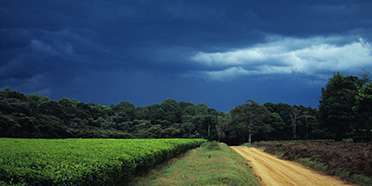- You are here:
- Home
- Countries & Parks
- Kenya Parks
- Kakamega Forest
- Reviews
- Expert Reviews
Expert Reviews – Kakamega Forest

Harriet is a zoologist with more than 20 years’ experience. She has the privilege of working with the world’s top wildlife photographers and photo-guides.
2 people found this review helpful.
Forest Birding Mecca!
Kakamega is Kenya’s last remnant of equatorial tropical rainforest. It is stunningly beautiful with huge trees draped in creepers and butterfly filled glades, ringing with birdsong and the crash of monkeys leaping through the canopy.
Kakamega attracts birders from around the world – it is a treasure chest of avian specials. Forest birding is notoriously difficult, so best to hire a local guide as you will hear and see so much more. You should hopefully see the Flinstone-esque great blue turaco flapping around in the canopy, the noisy black-and-white-casqued hornbill, the grey-throated barbet with its weird feathered bill, and, if you’re very lucky, tiny jewelled wattle-eyes, colourful forest bush shrikes and the blue-headed bee-eater. Three species of monkey are fairly easy to see – black-and-white colobus, red-tailed and blue, and the forest is also a reptile hot spot.
Kakamega is now much more accessible thanks to a new daily flight from Nairobi – a short 45-minute hop. The taxi drive from the airport along the red mud roads, through the lush forest, passing children walking to school, added to our memorable Kakamega experience.

Stuart is a travel writer and author of numerous Lonely Planet guidebooks, including 'Kenya', 'Rwanda' and 'Tanzania'.
3 people found this review helpful.
Find Your Inner Tarzan
Very different to almost any other park in Kenya, Kakamega is a slab of Congolese-like tropical forest buzzing with butterflies, shrill with birdsong and bustling with primates. True, it’s not going to tick any of the classic safari boxes but otherwise spending a few days exploring Kakamega is an absolute delight.
There are two parts to the park, the northerly section, which is a national park and has more pristine forest but higher entry fees and less accommodation options and a southerly sector which is managed by the forest department. The forest in this part is much more disturbed, but the choice of accommodation better and it’s cheaper to visit. Perhaps not surprisingly then most people visit this part.
Although the forest in the southern sector is more disturbed for the average non-expert it’s hard to tell the difference and going on an early morning forest walk with one of the highly knowledgeable guides will reveal birds and monkeys by the tree full.
As much as anything what I like about Kakamega is the opportunity to see a very different side of Kenya. These western hills are lush, green and covered in forests, farms and tea estates and the welcome is always genuine and warm. It’s a perfect contrast to the big savannah reserves elsewhere in Kenya.

Philip is an acclaimed travel writer and author of many guidebooks, including the Bradt guides to Uganda, Tanzania, Kenya and South Africa.
Kenya’s Top Birding Site
This is one of my favourite reserves anywhere in Kenya, and it is pretty much an essential diversion for any visitor with a serious interest in birds. An isolated western extension of the rainforest belt that extends from Central Africa into Uganda, the reserve protects 400-odd bird species, a list that is dominated by forest specials and includes more than 30 known from nowhere else in the country. The star among these is the great blue turaco, a comically gaudy bird that flops between trees like a colourful turkey, while other avian gems include bar-tailed trogon, blue-headed bee-eater, hairy-breasted barbet and innumerable woodpeckers and greenbuls. Be aware, however, that forest birding can be slow work, so a minimum stay of 2-3 nights is recommended, and it is best to do your walks with one of the excellent local guides. Birding aside, this is a lovely forest, with key mammalian attractions being black-and-white colobus, blue monkey and red-tailed monkey, along with the nocturnal potto, a sloth-like primate whose large eye are quite easily located by spotlight.

Lizzie is a reputed guidebook writer and author of the Footprint guides to South Africa, Namibia, Kenya, Tanzania, Uganda and Zimbabwe.
4 people found this review helpful.
A meander through spectacular equatorial rainforest
Kakamega is one of the last remaining (and fast diminishing) tropical rainforests of East Africa. By walking the narrow winding paths, I always find it such an extraordinarily beautiful and tranquil place. Its characterised by tangled vines, intermingled branches, a profusion of flowering plants including some exquisite orchids, and a chorus of screeches and mutterings from a whole host of African creatures. The wonderful (mostly self-taught) guides can quite astonishingly reel off the names of the flora and fauna in Latin. Shy forest creatures like grey duiker, bushpig, porcupine and clawless otter are present, but the dense forest floor makes them difficult to see. However my walks have always been accompanied by monkeys and baboons whooping through the trees and clouds of butterflies. Birds are abundant; hornbills, woodpeckers, honeyguides, turacos, and parrots are among more than 300 species. Not easy to get to and often rainy or misty, but its outstanding walking country.

Emma is an award-winning travel writer for Rough Guides, National Geographic Traveller, Travel Africa magazine and The Independent.
1 person found this review helpful.
Charming forest park in western Kenya
To me, Kakamega came as a delightful surprise. It’s a small, fragile fragment of what was once an extensive equatorial forest, and is the only reserve of its kind in Kenya. Human pressure has left the forest isolated and endangered, but rare plant and animal species continue to thrive here. There’s a truly peaceful atmosphere among the trees, many of which satisfyingly ancient-looking, with swirling buttress roots and lofty branches.
Kakamega is very low-key, with modest accommodation, so I’d recommend it to fairly adventurous types who enjoy forest walks among birds, monkeys and butterflies, with or without a guide. Biting insects love this shady habitat and the paths can be muddy, so you need to defend yourself with appropriate clothing and a good repellent.

Gemma authored several Lonely Planet guidebooks, including the guides to Africa, Kenya, Tanzania and South Africa.
1 person found this review helpful.
A walk in the woods for birders
Kakamega Forest is definitely not worth a trip to Western Kenya in its own right unless you are a birding fanatic, in which case you’ll definitely want to make a visit here a priority. I visited as a side trip from the pleasant town of Kisumu and loved the forest’s leafy green trails and gentle, knowledgeable local guides. It’s a very tranquil slice of virgin rainforest, replete with over 360 bird species along with black and white colobus monkeys and the odd leopard (which you are highly unlikely to spot). If you have time, I recommend staying overnight at the Isukuti KWS guesthouse, which is clean and basic and provided me with the chance to fall asleep listening to the forest’s amazingly loud night sounds.

Ariadne is a renowned African wildlife photographer whose work is featured in many well-known guidebooks and magazines.
1 person found this review helpful.
Kakamega FR – pristine forest and hard but phenomenal birding
Forests are not the most rewarding in terms of wildlife viewing. Walking along the forest trails might only give a glimpse of a monkey and unless you’re an experienced birder, the birds might be very elusive as well. Having said that, I just love forests and with deforestation being a major problem, any tract of pristine forest is priceless. Driving along the main road that bisects the forest in the early morning is a magical experience. School children walking along are silhouetted against the rising mist.
I came across a troop of blue monkeys playing in the canopy, which is viewed much easier from the road than from the narrow forest trails. Although hard work, the birding is phenomenal with a possibility to see many Central African specials at the limit of their range. Even if you’re not a birder, spectacular birds, like the great Blue Turaco will impress anybody.


 Kenya Parks
Kenya Parks
